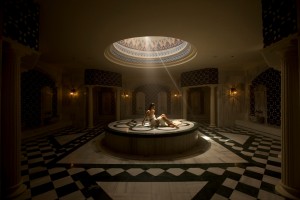
Spa Design is more than beauty, shapes, structures and comfortable cushions. It is about creating an environment and atmosphere that underpin the business in every respect and evoke an emotional response of your customers. A spa, assuming that it fulfils its function, has the ability to promote general relaxation and well-being.
In order to develop an appropriate spa design it is necessary to consider the following:
- Who do you target?
- What is your purpose?
- What is your vision?
- What is your concept?
- How do you want your clients to experience it?
- What should be the supporting technical development?
- What is your budget?
Based on several research projects, the client experience is a kind of non-cognitive factor, which is at least as important as other technical parameters. It includes how they were treated, communicated to, serviced and felt during their stay in your spa. The surrounding environment – with its smell, look, touch, music – will influence your guests’ overall feeling, by which they decide whether to come back to your spa again.
When preparing a floor plan we usually break down the space into “Income Generator”- such as treatment rooms or a retail area – and “Non-Income Generator” parts, such as the relaxing room, the corridor, the locker room, etc., without which the spa could not function at all. Besides your business plan and utilisation rate, which are very important factors to calculate with, there is a main constitution that will give the essence and characterise your facility: The energy flow, which is an inseparable part of your whole spa.
Recently, an increasing number of spas have been using Feng Shui to harmonise spaces and create a balanced atmosphere. Feng Shui has been used for thousands of years to help individuals live in harmony with nature and to increase health, prosperity and well-being. Feng means ’wind’, Shui means ’water’. Imbalance appears when chi (energy) becomes stagnant, excessive or deficient in a given space. Feng Shui is applied to smooth the harmonic flow of chi.
According to Feng Shui, the whole world is made of energy, also called vibration, which flows through you, your clients and your spa, interacting with everything it touches. A good energy flow in a spa promotes health, enjoyment and well-being, increases vitality and supports sales and growth.
Besides the famous Bagua-map, Feng Shui uses symbols, colours and strategic placement of objects to maximize the energy flow in a given space.
As Feng Shui has plentiful ideas for boosting the energy flow, here we have collected some features to contemplate in regards to your spa design:
- The entrance area is one of the most important places in your spa. This is where your guests step in first, therefore it must be inviting, peaceful and bright. Your main door should always be attractive and welcoming. Be aware that entrances with no window or proper lighting can stagnate the flow of chi. Strategically placed mirrors, lights or water fountains can compose the essential movement and wipe out the stagnating chi.
- Logo and name of the Spa should be well lit and placed at the entrance.
- The reception area, as the first interacting point, should be welcoming, not too big or long and not too far from the door itself; the desk should not be opposite to your entrance door. Place it adjacent and not parallel.
- Your waiting room should give the arriving clients a feeling that this is the place where they can take a breath and pause from their daily problems. Use soft pillows and comfy materials.
- The checking in/out stations should be clearly visible by your guests.
- Your front and back door – if existing – should not fall in a straight line, otherwise energy comes in to your spa and immediately goes away again.
- Place your massage table in a way to prevent feet and head from being directly in front of your treatment room’s door.
- Prepare a conscious floor plan.
- Use natural light if possible.
- Use well-chosen colours. Do not use red colours in the treatment room, it does not support relaxation.
- Apply adjustable lights all over the spa. The retail area should be well-lit, the treatment rooms or relaxing lounge should have comfortable lighting.
- Implicate adaptable and convenient music all over the spa. Rooms should have their own separate audio control panel.
- Avoid pointed shapes, sharp angles, dead ends. Use soft edges.
- Install proper ventilation. Apply Aromatherapy; always let fresh air into your spa.
- Crystals and gems create wonderful energy.
- Use salt crystals, rocks or ionization to improve and purify the air quality.
- Do not use broken or not properly working objects.
- You do not want to have a narrow, dark corridor with lots of doors. It speeds up chi and makes it uncomfortable for your clients to pass through. Ease this space with candles, crystals and mirrors.
- Your facilities should always be clean, tidy, well organized and your machines must function according to specific rules.
- Use all 5 elements: Water, Fire, Earth, Wood and Metal. If these elements are handled suitably they will fill your space with active, vital energies.
- Examples:
- Fire: candle, lighting, red or orange colours, triangular shape
- Water: blue colour, small fountain, splashing. (Avoid stable water surfaces as they swallow the energy.)
- Wood: green and purple colours, plants, standing in a rectangular shape
- Earth: natural colours, brown, crystals, stones, flowers, plants, lying rectangular shape
- Metal: white, silver, gold colours, round shape
- Examples:
For more details on Spa Design, please also check our previous article by Dr. Kurt Von Storch: “Spa Design and Spa Structure: The Atmosphere in a Hotel Spa”
Photo: © ELA Quality Resort Hotel, Belek, Turkey
